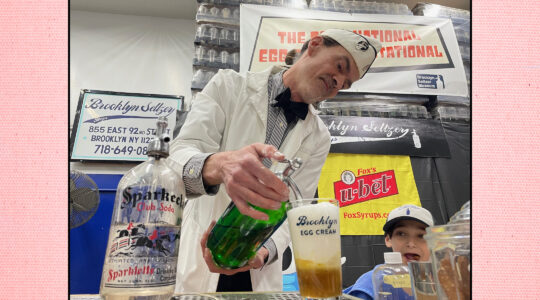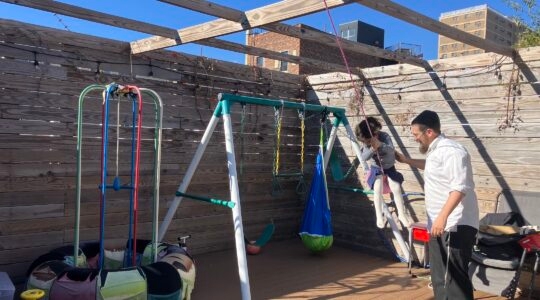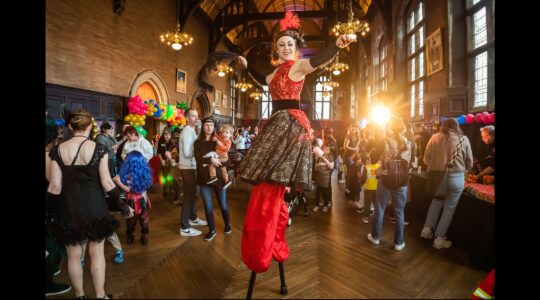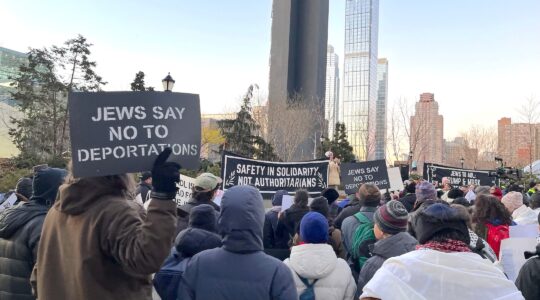It was a Devil’s Night, sirens and secrets, smoke and mirrors in which a killer stared back, a verse from Job, fires in the Manhattan sky and fear in a Brooklyn attic. There were tears in a cosmopolitan community on the Upper East Side, with a most beautiful shul, Kehilath Jeshurun, charred and roofless, and tears in Borough Park, a parochial community, for a beautiful child, Leiby Kletzky, dead and dismembered. Cosmopolitan, parochial, on the night of the locusts there was nowhere to hide.
“Tammuz was never a good month,” says Rabbi Haskel Lookstein of Kehilath Jeshurun (KJ), “and neither the first days of Av.” Historically, these are the Three Weeks of mourning. Make that four, say the Jews of the city, as the black Monday was precisely four weeks prior to Tisha B’Av, the most haunted night of the year.
These are the days when there are no weddings, no haircuts, no new clothes or ventures. Rabbi Yitz Greenberg has said, “The symbolic statement in these self-denials is: Who has the faith to go out and buy new things or plan for the future? Who has the heart to try to look good when the end is clearly drawing near?”
“The family doesn’t know,” said a chasid in the hallway outside the Kletzky apartment, taping a sheet of paper to the door that asked shiva visitors not to spread “rumors” or “stories” about how Leiby was not just murdered but … The chasid physically flinched, his sentence unfinished.
I thought of Leiby’s feet in the freezer, and the verse from the Song of Songs, “How beautiful are thy feet,” and how the socks on the feet of Elad Fogel, murdered in Israel a few months ago, were soaked with blood; how Alisa Flatow, killed on a bus in Israel years ago, was identified by her feet. In the new film, “Tree of Life,” a father’s large hands cup his newborn’s sole that had yet to take its first step.
There was another piece of paper posted by the family: “Dear esteemed reporters and members of the press: … We are forever grateful and thankful to Hashem (G-d). We would also like to express to each and every individual, to our friends and neighbors and our fellow New Yorkers… who assisted us above and beyond, physically, emotionally and spiritually…. From the depths of our mourning hearts, thank you.”
A plate of food was placed in front of Leiby’s father, Reb Nachman Kletzky, sitting on a low chair, formally dressed in his black suit and hat and a rip in his clothes. He didn’t touch the food, didn’t even look at it. A few chasidim whispered in Yiddish, their low voices drowned out by the air conditioner’s hum.
Norman Mailer, when writing about Marilyn Monroe, long after she died, would write with a vial of her perfume on his desk, as if to inhale her, to close his eyes and sense her as if she was just inches away. Before writing about Leiby, I wanted to close my eyes and inhale, as it were, the holiness of the Kletzky home, imagining their final Shabbat, him bouncing around with his five sisters, showing a multitude of facial expressions beyond the one with his downturned eyes. I wanted to wait for Leiby’s elevator and touch the worn button that he once would have had to reach for.
Sitting, meditating in the shiva room, I closed my eyes and envisioned “Shema,” almost surely Leiby’s last words. The cantillation to Eicha, the Book of Lamentations read on Tisha B’Av, floated through my head as I thought of Leiby’s father: “I am the man that has seen affliction.”
I arose and told Reb Nachman Kletzky, “HaMakom Yenachem… May God console you among the other mourners of Zion and Jerusalem.” HaMakom, the euphemism for God’s name, literally means “the Place,” a place where we knew God; this place — Borough Park — home to thousands of survivors acquainted with death, will console him, as well.
The loss of KJ is about a sense of place, a “makom,” all its own. Joni Usdan, who grew up in that shul and was married there, remembers stained glass like jewels, as if this was “Chartres,” the magnificent French cathedral. “The pews were tall, wooden, and enveloping (at least to a child), with red velvet cushions.” She remembers “the light filtering in, the weightiness of the marble columns, that majestic aura, matched by the top hats worn by the Looksteins.” A stained glass was dedicated by the Usdans in memory of her mother Roslyn, above the pew in “the ladies section” where mother and daughters sat each Shabbos.
The stained glass windows were backlit by the flames that were soaring through the roof. Several of the stained glass windows melted.
Rabbi Lookstein didn’t really hear about Leiby Kletzky until the day after the fire. “Oh my God. It bore out what I was telling everybody,” said Rabbi Lookstein. “We did not suffer a tragedy. We suffered a calamity. Tragedy is what happened to that boy in Brooklyn and his family. A building that can be rebuilt. You can’t rebuild that life.”
Borough Park was Leiby’s place, and like a verse from Lamentations, I “wandered in the street like the blind,” along Leiby’s last mile, down 44th Street, blind to the turn on 13th Avenue where he was to meet his mother. Forty-Fourth Street is leafy, bathed in shade and residential, where 13th Avenue – the block on which he should have turned — is bright and without shade, a commercial bazaar of shops selling candy, wigs, sforim (holy books), furniture; how does anyone not blinded miss that turn?
I wandered down 44th Street’s long, lonely blocks. A pair of chasidic children played in little red and yellow Playskool cars. There were no police, no grownups other than one or two who got in their cars and drove away. On 15th Street was Shomrim Locksmith, whose surveillance camera filmed Leiby as he walked on that Monday afternoon.
Then 44th Street ends, merging into Dahill Road and then into 18th Avenue. The neighborhood begins to change. Suddenly it was the end of the chasidic homes and the beginning of car collision shops, even a non-kosher food joint shoehorned amidst an outlying yeshiva. It’s a part of Borough Park where Chaim’s Upholstery is cheek to jowl with Iglesia De Evangelizacion. The urban forest grows dark, time to ask for directions.
“No one’s really lost,” said a chasidic woman, near Dahill. “God knows where you are.”
How do we remember where we are or where we were? When Rabbi Lookstein was a young boy (not much older than Leiby), growing up in KJ where his father and grandfather were the rabbis before him, he’d keep a journal in which he noted that particular Shabbat’s weather, his father’s sermon topic, his sense of how many were in attendance, if there was a special occasion. Now, all these years later, it seems that even the most ordinary Shabbat in the old burnt shul was a special occasion, after all.
At the end of the Three Weeks, in Borough Park and the Upper East Side, everywhere, there will be heard the sad song of Lamentations, “Hashivanu…” the yearning to be returned, “renew our days as of old,” even if it was only just days ago.
The New York Jewish Week brings you the stories behind the headlines, keeping you connected to Jewish life in New York. Help sustain the reporting you trust by donating today.




